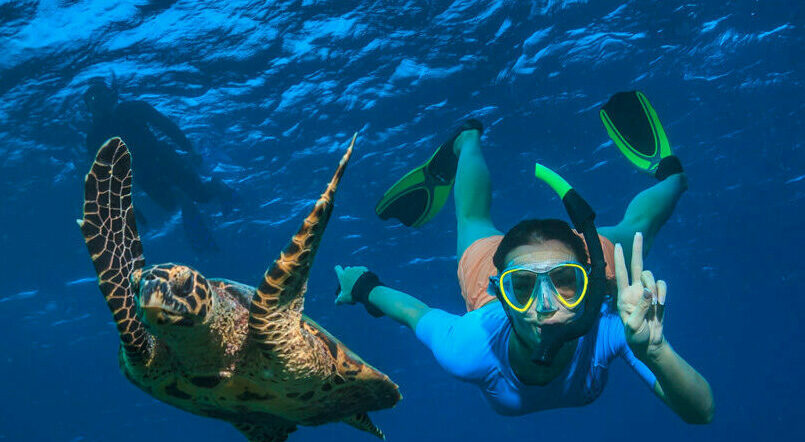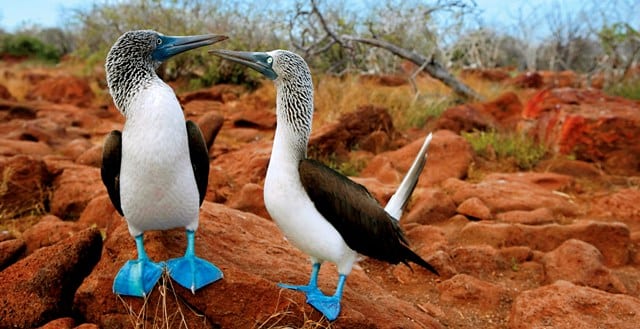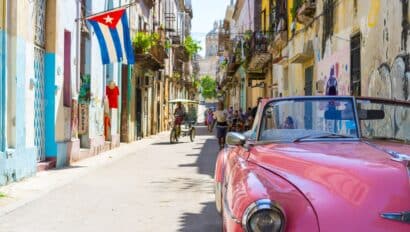No matter how well-traveled you may be, a trip to the Galápagos never ceases to inspire a strong sense of childlike wonder. Exploring these 19 volcanic islands in the Pacific Ocean off the coast of Ecuador, following in the steps of Darwin as you contemplate your place in natural history, guarantees a trip that will impact you long after you leave. Constant encounters with incredibly photogenic, often endemic wildlife that has never learned to be scared of humans while lazing on some of the most pristine beaches on the planet? Consider that a bonus.
But with so many islands to choose from, it can be a bit overwhelming trying to figure out the logistics of where to spend your time. Considering that 97% of the islands are a national park, it’s all gorgeous. We’ve got you covered, whether you prefer to dive the marine reserve to see little penguins zooming past marine iguanas, hike past towering cactuses or simply lounge on a volcanic black sand beach. Here are our top three Galápagos islands that you definitely don’t want to miss if you want to experience for yourself why AFAR magazine named our Galápagos trip the “Best Wildlife Encounter” in the world.
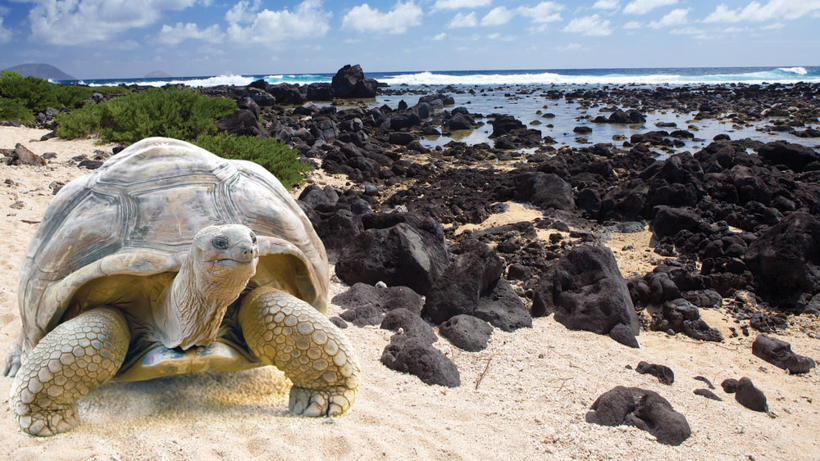
Isabela Island and the Las Tintoreras Islet
Many travelers who come here want to understand both the unique geology of the Galápagos and have the chance to see endangered species such as giant tortoises, Galápagos penguins, green turtles, sea lions, marine iguanas, and blue-footed boobies. Isabela Island gives you both opportunities in droves. The largest island by far of the archipelago, it is easily recognized on a map because it’s shaped like a seahorse. Located on the north side, the head of the sea horse is a very important marine area that gets hit by the Cromwell Current, supporting the most extraordinary marine life and making this one of the best diving spots in the entire archipelago. Whales and sharks are often spotted here. Isabela was formed into one big island mass by six volcanoes that in the beginning were six different islands (five of which are still active!). Each island used to be populated by a different species of tortoise, but now nature lovers can conveniently see them all in one place. From the 1600s to the 1800s, it is estimated that over 150,000 giant tortoises were killed for both meat and their impressive shell and, sadly, only between 20,000 and 25,000 remain. Of those, 5000 congregate on the slopes of Alcedo Volcano on Isabela Island. Sierra Negra Volcano has the second largest active crater in the world with a diameter of almost 6 miles at the widest point, and adventurers can hike to the rim to be rewarded with some incredible views.
Isabela is one of only four populated Galápagos islands; about 2200 people live in Puerto Villamil. Visible just offshore from Puerto Villamil is the Las Tintoreras Islet, a group of small islets (the largest being only 900 meters long with a width of just 100 meters), easily accessible from the comfort of a shaded panga boat. The bay here is sheltered and at low tide is connected to a pool of transparent water that provides a perfect spot to hang out with sea turtles, sea lions, stingrays, reef sharks, and marine iguanas.
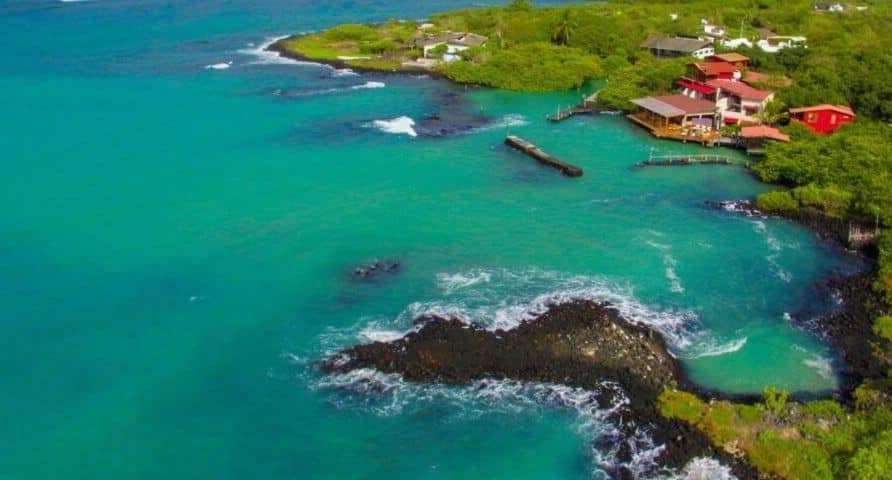
Santa Cruz Island
Most travelers arrive on Santa Cruz because of its proximity to the archipelago’s only airport on Baltra (to the north), and because its main town, Puerto Ayora, is the main tourism hub of the Galápagos. Unlike the rest of the tranquil islands, here you can enjoy restaurants, souvenir shops, coffee shops with internet, and even nightlife. There’s also the Charles Darwin Research Station, which has a breeding program for endangered giant tortoises that you can see from the time they are 3-inch hatchlings.
But don’t be fooled into thinking that Santa Cruz is lacking in natural landscapes. Santa Cruz has a huge variety of vegetation including pit craters, Scalesia Forest, cacti, and ferns, and the bay is a great spot to see brown pelicans, golden rays, marine iguanas, herons, lava gulls, frigate birds, Galápagos sea lions, and blue-footed boobies in mass quantities. Carrion Point in the north creates a sheltered lagoon with clear turquoise water, ideal for spotting rays and the harmless white-tip reef sharks.
What a lot of travelers unfortunately miss are the lava tunnels, formed as the outer skin of molten lava solidified but the liquid magma inside continued flowing, leaving behind a series of empty tubes. It’s possible to walk through these surreal underground channels, often a half mile in length, and aloof barn owls like to hang out here.
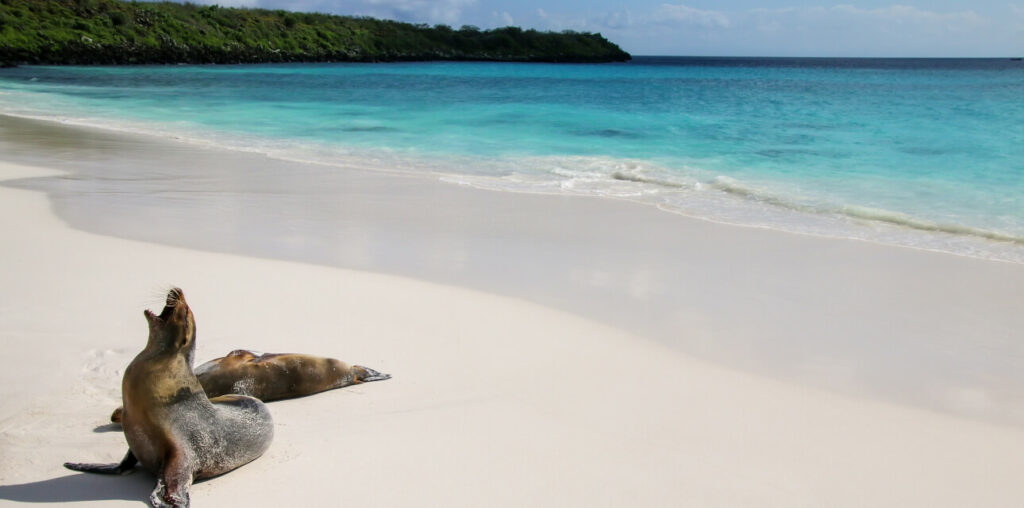
Sante Fe Island
Thought to be over four million years old, Santa Fe Island is one of the oldest in the Galápagos archipelago. Relatively tiny at only 9.3 square miles, this flat island has interesting vegetation of palo santo trees and forests of huge and very photogenic pear cacti called Opuntia echios. With its location only 40 minutes by boat from Santa Cruz, visitors can take a day trip to Santa Fe to enjoy walking and snorkeling – the island is unpopulated (and always has been) and there is zero infrastructure here. Geologically Santa Fe is different from other Galápagos Islands because it was not formed by a volcano, but an upliftment.
Wildlife lovers will be happy to hear that this is the island with the highest endemism (thanks to its age and isolation). Here the marine iguana can be seen in droves, as well as the Santa Fe mockingbird, the Santa Fe rice rat, and the Santa Fe lizard. The island has one of the most stunning and sheltered coves in the Galápagos that attracts the endemic Galápagos hawk, Darwin’s finches, and land iguana.
Book Your Trip Today!
The sensorial Galápagos is one of our favorite places in the world to share. Whether hiking alongside four-foot-long marine iguanas that don’t scuttle out of your way for anything, coming back from an afternoon snorkeling with penguins only to find a sleepy sea lion napping on your beach towel, or silently taking in the expansive view from the rim of the world’s second-largest volcanic caldera, we offer you adventure-filled days followed by restful nights at luxury waterfront boutique hotels. And in a place so in need of protection such as the Galápagos, you’ll rest extra easy knowing that we follow ‘Leave No Trace’ environmental standards. Not resting on even those laurels, this Classic Journey also supports more than 50 local residents and their families.
Are you ready to experience the Galápagos Islands with us on foot and at eye level? Start planning your trip of a lifetime by contacting our Travel Experience Team.
